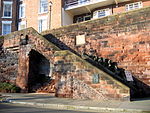Nine Houses, Chester
Almshouses in CheshireGrade II listed buildings in ChesterGrade II listed housesHouses completed in the 17th centuryHouses in Chester ... and 3 more
Medieval architectureTimber framed buildings in CheshireUse British English from July 2017

The Nine Houses, of which only six remain, are in Park Street, Chester, Cheshire, England. The row of houses is recorded in the National Heritage List for England as a designated Grade II listed building. They face the eastern portion of Chester city walls.
Excerpt from the Wikipedia article Nine Houses, Chester (License: CC BY-SA 3.0, Authors, Images).Nine Houses, Chester
Park Street, Chester Handbridge
Geographical coordinates (GPS) Address Nearby Places Show on map
Geographical coordinates (GPS)
| Latitude | Longitude |
|---|---|
| N 53.1884 ° | E -2.8881 ° |
Address
Park Street
Park Street
CH1 1RN Chester, Handbridge
England, United Kingdom
Open on Google Maps









